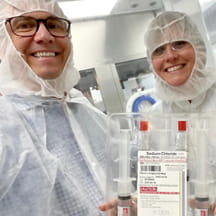Perspectives in pain management
In this series, Children's Hospitals Today explores balancing the use of opioids to ensure children's hospitals can adequately treat pain in children.
Amy, an adolescent from Columbus, was prescribed Vicodin after her knee surgery.
"They kept prescribing it, so I kept taking it," Amy said. Still, she wanted more. So, she unfastened her seat belt and set her sights on dumpsters ahead. Then she stepped on the gas. She ducked her head as she crashed into the dumpsters head on—all so she could get another opioid prescription.
This is a true story that played out in a public service announcement (PSA) series last year from the Truth Campaign. Each PSA showed how far some young people were willing to go to get another prescription for opioids—how willing they were to hurt themselves to feed their addiction, from smashing their hands with a hammer to allowing the body of a car to fall onto their chest.
The opioid epidemic
Every day, more than 130 Americans die after overdosing on opioids, according to the National Center for Health Statistics. That's one person every 11 minutes. Children and adolescents are far from immune to this national emergency—nearly 1 in 4 high school seniors in the U.S. have been exposed to prescription opioids through medical or non-medical use. Even younger children are at risk; common injuries such as broken bones have historically led to an opioid prescription for pain.
But Joshua Abzug, M.D., University of Maryland School of Medicine associate professor of orthopedics and pediatrics, and a University of Maryland Children's Hospital pediatric orthopedic surgeon, says it's time to re-examine how to manage pain in young patients—including limiting the number of opioids prescribed in the first place.
"A routine prescription may have been to give out 30 pills five or six years ago," says Abzug. "Several studies have come out to look at how many pills a child or patient needs after an operation and we found that they need far less than that."
According to Abzug, some patients may only need a prescription for a few pills to manage their pain. Prescribing just the right amount is critical because addiction among children and adolescents often stems from simply having leftover pills around. The entrée into opioids as a drug for recreational use in three-quarters of the kids, he says, is a legitimate prescription following an operation or injury where they use the drug short term or not at all—but then go on to use their own leftover pills and then seek out pills from a parent or a friend.
"The entrée is a passive entrée, where the opportunity is there, and the child takes that opportunity," says Abzug.
Do we need opioids?
Orthopedic surgeons are top opioid prescribers because the conditions they treat are frequently associated with severe pain. Abzug's approach is to consider whether opioids are necessary or if anti-inflammatories would be sufficient to manage the child's pain. If not, a combination may be in order, he says."In surgeries and injuries where we know the child will be in substantial pain, we look to a combination—what we call multi-modal pain medication management—so that maybe they get some opioids," Abzug says. "But instead of getting a high level of opioids—or opioids for a long period of time—we get them off the opioids quickly by using more anti-inflammatories, injectable Tylenol and local anesthetics."
What can prescribers do? Four tips from Abzug:
- Set expectations with patients and parents. This is by far the most important thing a provider should do. Setting the right expectations around the injury or operation from the outset—along with anticipated pain levels and pain management plans—helps parents understand whether an opioid will or may be necessary and how much of that medication may be needed.
- Educate other providers. Surgeons should educate emergency department and urgent care providers to limit the number of opioids prescribed—or to not prescribe an opioid at all for musculoskeletal injuries in children and adolescents.
- Keep up with research. All medical providers should stay abreast of current and ongoing research about opioids and rethink the historical opioid prescribing practices, so children only get opioids if needed.
- Set a plan for disposing unused narcotics. Talk with families about the best disposal of leftover opioids: place them in cat litter or dirt and dispose of them.
Want more information?
Abzug, together with other doctors with the Pediatric Orthopaedic Society of North America, recently published a review article examining the current state of the opioid epidemic as it relates to pediatric orthopedics and to present strategies for pain management, education, research and advocacy.


